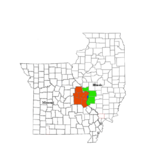Orthwein Mansion
Orthwein Mansion | |
 Orthwein Mansion | |
| Location | 15 Portland Place, St. Louis, Missouri, US |
|---|---|
| Coordinates | 38°38′51″N 90°16′01.4″W / 38.64750°N 90.267056°W |
| Built | ca. 1900 |
| Architect | Frederick Widmann Robert W. Walsh Caspar D. Boisselier |
| Architectural style | Colonial Revival architecture |
| Part of | Portland and Westmoreland Places (ID74002276[1]) |
| Designated CP | February 12, 1974 |
The Orthwein Mansion is a historic mansion in St. Louis, Missouri, in the United States. It sits at 15 Portland Place, near the northeastern corner of Forest Park.
The mansion was built c. 1900,[1] for William D. Orthwein, a German immigrant.[2] It was designed in the Neoclassical architectural style,[1] by Frederick Widmann, FAIA (1859-1925), Robert W. Walsh, FAIA (1860-c.1929) and Caspar D. Boisselier.[2]
William D. Orthwein, his wife Emily, and their family lived there for 27 years.[3] Their son William R. Orthwein was living there when he competed at the 1904 Summer Olympics, held in St. Louis, in the freestyle and backstroke swimming and water polo, winning bronze medals in the 4x50-yard freestyle relay and water polo.[4]
The house has been listed on the National Register of Historic Places since February 12, 1974.[5]
References
[edit]- ^ a b c Stephen J. Raiche (April 20, 1973). "National Register of Historic Places Inventory - Nomination Form: Portland and Westmoreland Places" (PDF). Missouri Department of Natural Resources State Historic Preservation Office. Retrieved October 5, 2015. Includes a map of the district.
- ^ a b "Orthwein Mansion - Portland and Westmoreland Places - St. Louis, Missouri". Way Marking. Retrieved August 25, 2015.
- ^ Julius K. Hunter; Robert C. Pettus; Leonard Lujan (1988). Westmoreland and Portland Places: The History and Architecture of America's Premier Private Streets, 1888-1988. University of Missouri Press. pp. 53–. ISBN 978-0-8262-0677-0. Retrieved October 6, 2015.
- ^ Mannino, Fran. "Tour Central West End's Portland Place". West End World. Retrieved October 6, 2015.
- ^ "Portland and Westmoreland Places". National Park Service. Retrieved August 25, 2015.




